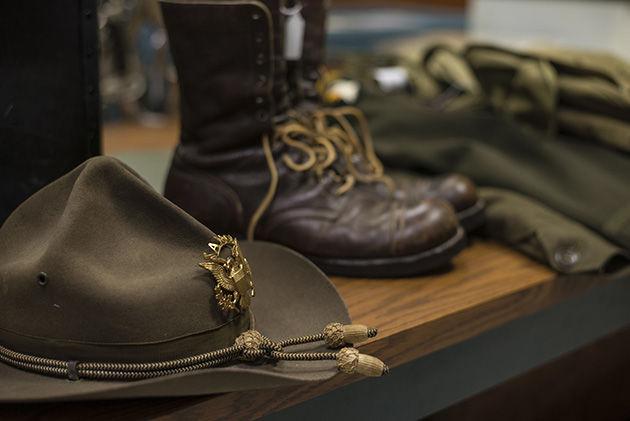Bastogne, Belgium, is half a world away, and yet this December an exhibit will launch there called, “Texas Aggies Go to War,” in commemoration of the 70th anniversary of the Battle of the Bulge.
Bastogne received the brunt of the German attack during the Battle of the Bulge, a large German counterattack during World War II in late 1944. Joseph Dawson, history professor, said the Battle of the Bulge pivoted on Bastogne.
“It involved United States, Britain, many air force units — it was truly an allied effort in addition to being the biggest battle for Americans,” Dawson said. “Bastogne sort of formed the location in the battle on which everything seemed to turn. Americans recognized this and the Germans recognized this and they were justifiably disappointed they couldn’t force the American defenders out of the town.”
Brent Cornwell, associate vice chancellor for commercialization, said the idea for the exhibit was driven entirely by Belgians. Philippe LaChapelle, a Belgian work associate of Cornwell’s, helped drive the idea to include A&M in the exhibit.
“Philippe was talking to a colleague in Bastogne, Belgium, and [the colleague] said, ‘Well, the 70th anniversary of Battle of the Bulge is coming up and so we are thinking of redoing the museums for the Battle of the Bulge,’” Cornwell said. “And my friend Philippe says, ‘Well, why don’t you tell the story of Texas Aggies fighting in the Battle of the Bulge.’ And his Belgium friend said, ‘What the hell is a Texas Aggie?’ And Philippe started to explain to them about who Texas A&M was and what we stood for.”
Cornwell said the museum exhibit will highlight the lives of five Aggies — Lt. Col. James Earl Rudder, Capt. Joe E. Routt, Maj. James F. Hollingsworth, Lt. Turney W. Leonard and Lt. William M. Pena.
“They wanted to tell the story of American support for Belgium liberation through the eyes of five Aggies and use those Aggies as the everyman for the solider,” Cornwell said. “It’s really not a story about the five most heroic Aggies, or the five most deserving Aggies that fought in World War II. It’s really a way to take individuals to make the story relatable to young people today.”
Cornwell said the designers of the museum visited A&M to learn more about its culture.
“The Belgians want to tell the story of Texas A&M, that to me is the most compelling aspect of this,” Cornwell said. “This was not someone from Texas A&M marketing selling them. The people from the museum came here, recognized the specialness of the university, the uniqueness of the culture and wanted to tell that story.”
Lisa Kalmus, curator of the Sanders Corps of Cadets Center, said a total of 20,229 Aggies served in World War II, 14,123 served as officers and 953 died in service during World War II.
“Providing over 20,000 to serve from one institution, when usually at the time you had five, six, seven thousand students at any given time, that’s a major contribution,” Kalmus said. “Far ranging, far reaching, their impact was so significant.”
Kalmus said during World War II, A&M was fully geared toward helping the war effort.
“You had the Class of 1942 graduating about a month early, and you had a huge ramping up here,” Kalmus said. “You also had the change where they were going three semesters per calendar year. If you were here as a student and were able to take enough classes you could technically finish in two and a half years, but most of these guys were called up to service.”
Kalmus said the true scope of A&M contribution could be seen when Reveille I passed away in 1945 before the end of the war.
“Reveille died in January of 1945. You just finished the Battle of the Bulge and things had just started to turn, this went out around the world,” Kalmus said. “You had flowers and telegrams and condolences and everything coming from basically around the world, all of these former students who are serving all around the world who of course knew of Reveille.”
Kalmus said the history of the Corps, especially around World War II, is not just the Corps’ history — it belongs to every Aggie.
“They will say, ‘Well, that’s Corps,’” Kalmus said. “Well, up until 1963, this is inclusive history, this is every Aggies history to be able to see the stories and view the items and the things that tell the story about A&M’s beginning, about its tradition and about its contribution.”
Dawson said the exhibit represents the impact of A&M students during World War II.
“It has the potential to attract a number of visitors to Bryan and to College Station,” Dawson said. “What is remarkable is the deep impression that A&M former students made on the group of residents of Bastogne.”
Cornwell said the exhibit is not just history — it is about the connections A&M makes across the world and about telling a story.
“The museum that is being designed in Bastogne is not simply a historical museum about what happened in December of 1944 and January of 1945,” Cornwell said. “It’s a story that tells the story of war and sacrifice and friendship and ongoing healing between Germany, Belgium and the United States. And that story is being told through A&M.”
Belgian exhibit shines light on A&M WWII effort
September 30, 2014
0
Donate to The Battalion
$2790
$5000
Contributed
Our Goal
Your donation will support the student journalists of Texas A&M University - College Station. Your contribution will allow us to purchase equipment and cover our annual website hosting costs, in addition to paying freelance staffers for their work, travel costs for coverage and more!
More to Discover










